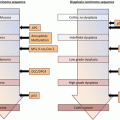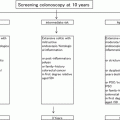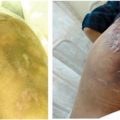78.
Connell WR et al (1994) Lower gastrointestinal malignancy in Crohn’s disease. Gut 35(3):347–352PubMedCentralPubMed
79.
Higashi D et al (2007) Study of colorectal cancer with Crohn’s disease. Anticancer Res 27(6A):3771–3774PubMed
80.
Iesalnieks I et al (2010) Fistula-associated anal adenocarcinoma in Crohn’s disease. Inflamm Bowel Dis 16(10):1643–1648PubMed
81.
Baars JE et al (2011) Malignant transformation of perianal and enterocutaneous fistulas is rare: results of 17 years of follow-up from The Netherlands. Scand J Gastroenterol 46(3):319–325PubMed
82.
Mpofu C, Watson AJ, Rhodes JM (2004) Strategies for detecting colon cancer and/or dysplasia in patients with inflammatory bowel disease. Cochrane Database Syst Rev 2:CD000279PubMed
83.
Collins PD et al (2006) Strategies for detecting colon cancer and/or dysplasia in patients with inflammatory bowel disease. Cochrane Database Syst Rev 2:CD000279PubMed
84.
Itzkowitz SH et al (2005) Consensus conference: Colorectal cancer screening and surveillance in inflammatory bowel disease. Inflamm Bowel Dis 11(3):314–321PubMed
85.
Devon KM et al (2009) Cancer of the anus complicating perianal Crohn’s disease. Dis Colon Rectum 52(2):211–216PubMed
86.
Laurent S et al (2005) Development of adenocarcinoma in chronic fistula in Crohn’s disease. Acta Gastroenterol Belg 68(1):98–100PubMed
87.
Velayos FS, Terdiman JP, Walsh JM (2005) Effect of 5-aminosalicylate use on colorectal cancer and dysplasia risk: a systematic review and metaanalysis of observational studies. Am J Gastroenterol 100(6):1345–1353PubMed
88.
Bernstein CN, Nugent Z, Blanchard JF (2011) 5-aminosalicylate is not chemoprophylactic for colorectal cancer in IBD: a population based study. Am J Gastroenterol 106(4):731–736PubMed
89.
Terdiman JP et al (2007) 5-Aminosalicylic acid therapy and the risk of colorectal cancer among patients with inflammatory bowel disease. Inflamm Bowel Dis 13(4):367–371PubMed
90.
Nguyen GC, Gulamhusein A, Bernstein CN (2012) 5-aminosalicylic acid is not protective against colorectal cancer in inflammatory bowel disease: a meta-analysis of non-referral populations. Am J Gastroenterol 107(9):1298–1304, quiz 1297, 1305PubMed
91.
van Schaik FD et al (2012) Thiopurines prevent advanced colorectal neoplasia in patients with inflammatory bowel disease. Gut 61(2):235–240PubMed
92.
Pasternak B et al (2013) Use of azathioprine and the risk of cancer in inflammatory bowel disease. Am J Epidemiol 177(11):1296–1305PubMed
93.
Armstrong RG, West J, Card TR (2010) Risk of cancer in inflammatory bowel disease treated with azathioprine: a UK population-based case-control study. Am J Gastroenterol 105(7):1604–1609PubMed
94.
Onizawa M et al (2009) Signaling pathway via TNF-alpha/NF-kappaB in intestinal epithelial cells may be directly involved in colitis-associated carcinogenesis. Am J Physiol Gastrointest Liver Physiol 296(4):G850–G859PubMed
95.
Fearon ER, Vogelstein B (1990) A genetic model for colorectal tumorigenesis. Cell 61(5):759–767PubMed
96.
Karin M, Greten FR (2005) NF-kappaB: linking inflammation and immunity to cancer development and progression. Nat Rev Immunol 5(10):749–759PubMed
97.
Grivennikov SI, Greten FR, Karin M (2010) Immunity, inflammation, and cancer. Cell 140(6):883–899PubMedCentralPubMed
98.
Noguchi M et al (1998) Secretion imbalance between tumour necrosis factor and its inhibitor in inflammatory bowel disease. Gut 43(2):203–209PubMedCentralPubMed
99.
Wallis RS (2008) Tumour necrosis factor antagonists: structure, function, and tuberculosis risks. Lancet Infect Dis 8(10):601–611PubMed
100.
Di Girolamo N et al (1997) Expression of TNF-alpha by human plasma cells in chronic inflammation. J Leukoc Biol 61(6):667–678PubMed
101.
Szlosarek P, Charles KA, Balkwill FR (2006) Tumour necrosis factor-alpha as a tumour promoter. Eur J Cancer 42(6):745–750PubMed
102.
Popivanova BK et al (2008) Blocking TNF-alpha in mice reduces colorectal carcinogenesis associated with chronic colitis. J Clin Invest 118(2):560–570PubMedCentralPubMed
103.
Bromberg J, Wang TC (2009) Inflammation and cancer: IL-6 and STAT3 complete the link. Cancer Cell 15(2):79–80PubMedCentralPubMed
104.
Bollrath J et al (2009) gp130-mediated Stat3 activation in enterocytes regulates cell survival and cell-cycle progression during colitis-associated tumorigenesis. Cancer Cell 15(2):91–102PubMed
105.
Esfandi F, Mohammadzadeh Ghobadloo S, Basati G (2006) Interleukin-6 level in patients with colorectal cancer. Cancer Lett 244(1):76–78PubMed
106.
Li Y et al (2010) Disease-related expression of the IL6/STAT3/SOCS3 signalling pathway in ulcerative colitis and ulcerative colitis-related carcinogenesis. Gut 59(2):227–235PubMed
107.
Matsumoto S et al (2010) Essential roles of IL-6 trans-signaling in colonic epithelial cells, induced by the IL-6/soluble-IL-6 receptor derived from lamina propria macrophages, on the development of colitis-associated premalignant cancer in a murine model. J Immunol 184(3):1543–1551PubMed
108.
Foran E et al (2010) Upregulation of DNA methyltransferase-mediated gene silencing, anchorage-independent growth, and migration of colon cancer cells by interleukin-6. Mol Cancer Res 8(4):471–481PubMed
109.
Huang S, Ullrich SE, Bar-Eli M (1999) Regulation of tumor growth and metastasis by interleukin-10: the melanoma experience. J Interferon Cytokine Res 19(7):697–703PubMed
110.
Greten FR et al (2004) IKKbeta links inflammation and tumorigenesis in a mouse model of colitis-associated cancer. Cell 118(3):285–296PubMed
111.
Fukata M, Abreu MT (2008) Role of Toll-like receptors in gastrointestinal malignancies. Oncogene 27(2):234–243PubMedCentralPubMed
112.
Maeda S, Omata M (2008) Inflammation and cancer: role of nuclear factor-kappaB activation. Cancer Sci 99(5):836–842PubMed
113.
Fukata M et al (2007) Toll-like receptor-4 promotes the development of colitis-associated colorectal tumors. Gastroenterology 133(6):1869–1881PubMedCentralPubMed
Stay updated, free articles. Join our Telegram channel

Full access? Get Clinical Tree








